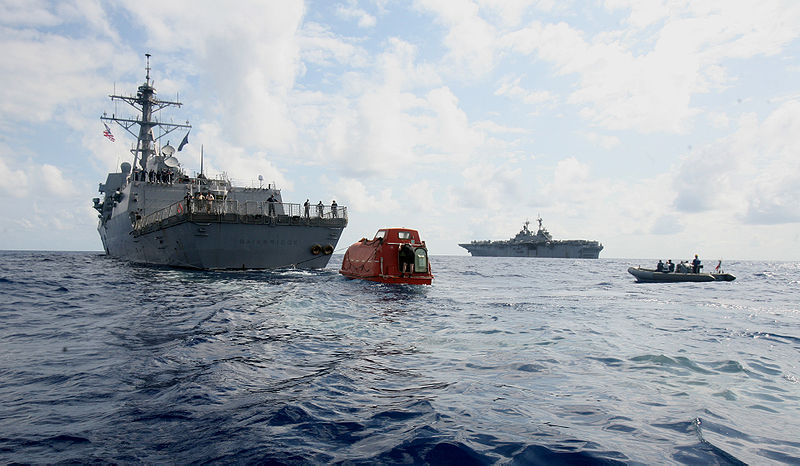
Kidnappings and hijackings off the coast of Somalia have been the topic of sensationalist media attention over the last few years. When Americans Jean and Scott Adam, Phyllis Macay, and Bob Riggle were killed this past February in a Somali hijacking, most saw a one-dimensional report of a crime committed by a barbaric people.[i] The situation is generally typecast as a problem necessitating a simple solution of naval intervention. A closer look into these instances, however, shows the historic intricacies of the problems in the Horn of Africa that have caused the Somali people to become desperate, thus turning to piracy as one of only few viable options. These attacks generally occur around the Gulf of Aden due to the geo-strategic importance of the area, as it is an entry and exit point for shipping routes to and from the Suez Canal. The world at large is attacking the problem the wrong way. The current military strategy is compounding the problem, as it lacks historic or long-term insight. The international community must envision new solutions for Somalia and the Gulf of Aden to affect lasting stability.
Plagued by nearly 200 years of oppression and civil war, Somalia today is a failing state ruled by strong men and militias. Lawlessness in Somalia has allowed global corporations to dump their toxic, medical, and nuclear waste off the coast entirely unchecked.[ii] For nearly a decade this semi-legal dumping persisted until a tsunami hit in December of 2004 and washed untold amounts of toxic waste onto the shores of Somalia. The toxic waste saturated the shoreline and destroyed any economic production Somalia might have had, including its fishing industry.[iii] Enraged, the Somali people decided to fight back against the world that denigrated them.
In an interview, Sugule Ali, a pirate leader, stated, “We don’t consider ourselves sea bandits. We consider sea bandits [to be] those who illegally fish and … dump waste in our seas and carry weapons in our seas.”[iv] The fishermen, who were driven out of business by war and pollution, have turned to vigilantism to protect their waters. Their livelihood was threatened and no one came to their aid.
These Somali vigilantes captured vessels in the Gulf. The lack of strategy devolved the situation into violence and kidnapping. Not knowing how to handle the crisis, nations and corporations gave in to the demands of the ex-fishermen, now pirates, with a cash ransom. For example, the South Korean Buhan’s Samho Shipping Company paid hijackers $9 million to return their personnel and goods.[v] In a wealth-less, polluted, war-torn nation, any source of income is celebrated and the opportunity is exploited. The frequency and sheer audacity of the Somali pirate attacks grew as word spread on how to achieve a quick income.[vi]
The Military powers responded only after an American ship, the Maersk-Alabama, was attacked. This sparked the United States to expand its ‘War on Terror’ to encompass patrolling the waters of Somalia with a naval task force to intercept suspected pirates.[vii] Later NATO, the European Union and China started patrolling the Gulf of Aden with missions called Ocean Shield and ATALATA.[viii] According to these missions, if NATO flotillas capture a suspected pirate they are, more often than not, handed off to the African Union for judiciary punishment.[ix] The threat of jail or even death does not deter piracy in the region; the threat still persists and it is on the rise.[x]

An article published by The Economist outlining the piracy situation cited the United Nations’ estimate that Indian Ocean piracy costs the world between $5 billion and $7 billion annually. The frequency of attack is at an all-time high. In January 2011 alone thirty-three vessels were taken hostage – equating to more than one per day.[xi] The hijacking tactics used are also becoming more sophisticated. Initially attacks were conducted close to the shore. Now that better ships have been hijacked for use, and Somalis have used ransom funds for better armaments, the pirates have become bolder.
Their tactic today is to use a larger ‘Mother Ship’ in the open ocean, from which they send smaller boats in to attack. These Mother Ships have been known to operate as far south as the Seychelles, and as far west as the Maldives. This tactic gives the pirates the ability to get in, take hostages, and get out before the rescue force can arrive.[xii] As a result of this effective tactic the pirates’ demands increase. If history teaches us anything, things will get worse before they get better this year.
The powers that be are combating the problem the wrong way. Nearly one tenth of the world shipping travels through the Gulf of Aden,[xiii] so the world has a vested interest in seeing that shipments make it through safely. The short-term fix of a naval task force patrolling the waters is not deterring the economically desperate Somalis and is dodging the real problem. If the international community seeks to save the lives of innocent mariners and pirates alike, serious decisions need to be made. First, the United Nations needs to pass resolutions discouraging ransom payment to the pirates. The African Union, European Union, Arab League and the Shanghai Cooperation Organization should also pass similar guidelines. This is another short-term fix but it is appropriate. Second, in order to save on escalating insurance premiums and to save the lives of its citizens, the G20 needs to establish a coordinated environmental cleanup of the region.
It is safe to assume that the containers holding the toxic waste have no country-specific designators. However, it is appropriate for the clean up to be a coordinated G20 operation because they are the only states in an economic position to do so, even in the current economic climate. The economic losses that will occur if shippers refuse to use the Suez and Gulf of Aden as a transit route will be staggering, for all the industrialized nations. If the Saudi government decides to stop shipping oil through the Gulf of Aden, the price of gasoline has the potential to reach astronomical prices in the West to account for the added shipping costs of travel around the Cape of Good Hope. The economic implications would be devastating. That being said, the military missions now in place should re-evaluate their mission to patrol for pirates but also ensure that toxic dumping practices do not continue.
The situation in Somalia gets worse every year for its people and the world at large. Throwing a small armada off the coast will not solve the problem no more than the payment of ransoms. No one could have seen that a short-term solution like dumping toxic waste could spark a wave of international piracy a decade later. Short-term fixes only beget more problems. A sustained, systematic commitment by the industrialized nations must transpire in order to solve the problem. If a long-term plan does not come to light now, maritime piracy has the potential to escalate and spiral out of control and infect other economically disparaged regions. Global maritime security, economic prosperity, and the lives of countless individuals are at stake.
[i] MSNBC, “Four American Hostages Killed by Somali Pirates.” MSNBC, February 22, 2011. http://www.msnbc.msn.com/id/41715530/ns/world_news-africa/
[ii] Najad Abdallahi, “Toxic Waste Behind Somali Piracy” Al-Jazeera, October 11, 2008. http://english.aljazeera.net/news/africa/2008/10/2008109174223218644.html
[iii] Abdallahi, 2008.
[iv] Johann Hari, “You Are Being Lied to About Pirates” The Huffington Post, January 4, 2009. http://www.huffingtonpost.com/johann-hari/you-are-being-lied-to-abo_b_155147.html
[v] United Press International, “South Korea Charges Alleged Somali Pirates,” United Press International, Ltd., February 28, 2011. http://www.upi.com/Top_News/Special/2011/02/28/South-Korea-charges-alleged-Somali-pirates/UPI-37441298892600/
[vi] The Economist, “Piracy: No Stopping Them,” The Economist, Vol. 398, no. 8719, p. 69-71, February 3, 2011.
[vii] United States Navy, “Combined Task Force 150 Maintains Presence Off East Coast of Africa,” United States Navy, January 5, 2007. http://www.navy.mil/search/display.asp?story_id=27242
[viii] NATO, “Counter-Piracy Operations,” North Atlantic Treaty Organization, February 4, 2011. http://www.nato.int/cps/en/natolive/topics_48815.htm?selectedLocale=en
[ix] See note 6.
[x] See note 6.
[xi] See note 6.
[xii] Los Angeles Times, “The Scourge of Somalia,” Los Angeles Times, February 23, 2011. http://articles.latimes.com/2011/feb/23/opinion/la-ed-somalia-20110223
[xiii] “Pirates Threaten Ship Traffic In Gulf of Aden,” Poten and Partners, October 23, 2008. http://www.poten.com/PubHeadlines.aspx?id=4732


